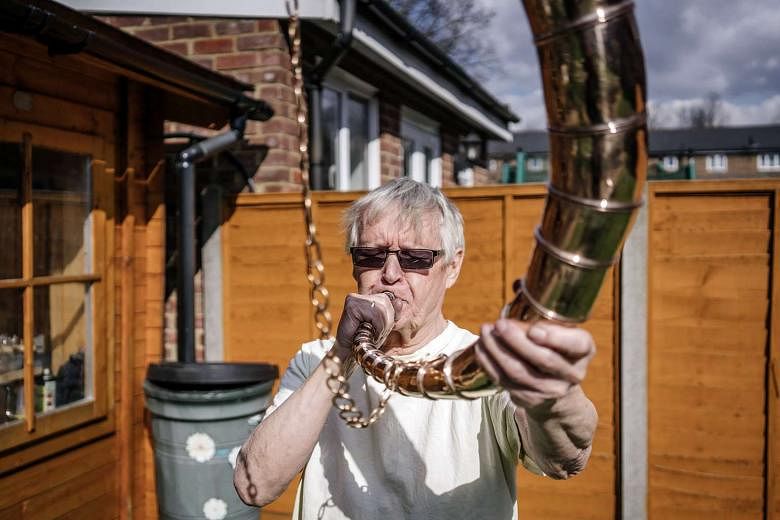LONDON • Former aircraft engineer Peter Holmes was standing in his tidy living room in North London recently, holding a Scandinavian war horn more than 1.2m long.
When asked how the instrument, known as a lur, is played, he said: "I've no idea. No one's played it for 3,000 years."
With that, he put the lur to his lips and blew. Rather than an angry bellow that might transport a listener to a lonely fjord among Viking warriors, it sounded more like a bugle played by someone with a lisp.
Mr Holmes, 76, an expert on ancient music, built the lur and other long-forgotten instruments at the University of Middlesex's engi- neering department, where he is designer in residence, and in his cluttered garden shed.
He is a central figure in the European Music Archaeology Project, or Emap, a €4-million (S$6.1-million) effort started in 2013 to recreate the sounds of the ancient world.
The project is unveiling the results of its work this year. It started with a concert in Glasgow, Scotland, last Saturday, followed by a touring exhibition that opens on June 6 in Ystad, Sweden.
Classical record label Delphian is also releasing a series of albums as a tie-in with the project, starting with works of ancient Scottish music next month.
Ancient instruments are important because they offer a different perspective on the past, said Mr John Kenny, a trombonist from Birmingham, England, who also plays the carnyx, an Iron Age horn.
"I've witnessed the most extraordinary skills used to reconstruct buildings, clothes and language," he said, "but those don't put you into the imaginative world people used to live in. Only music does that."
"If you reconstruct a sword," he added, "no one apart from a homicidal maniac could use it for the purpose intended. But reconstruct an instrument and anyone can experience it."
The project, half funded by the European Union, with the rest coming from an assortment of institutions and state agencies, spans the Paleolithic era to around AD1000 and the Dark Ages. Calling on the skills of archaeologists, philologists, acousticians, metal workers and others, it has brought back to life everything from ancient bagpipes to 30,000-year-old vulture bone flutes.
Mr Holmes' love of the trumpet had led him to trace its origins further and further back until, in 1962, he found himself reconstructing an antecedent to the instrument that had been found in Egyptian pharaoh Tutankhamen's tomb.
"It used to be just a few of us enthusiasts doing it," he said, "but now it's become a lot more professional. We're using high-precision engineering tools, 3D printers, all sorts of things."
Mr Kenny, 59, was introduced to the carnyx in the early 1990s when a Scottish musicologist, knowing of his interest in early music, knocked on his door and told him he was needed to help reconstruct one that had been excavated in 1816 at a farm near Deskford, in northern Scotland, but was languishing in a museum storeroom.
A carnyx towers 1.8m above the player and is topped by a serpent or boar's head - its mouth sometimes able to flap open and closed to mute the sound. The first reconstruction sounded like "a fart in a bottle", Mr Kenny said. "It wasn't a human instrument. It had no inner life and I was sure that was because we didn't use the original techniques to make it or the original alloys."
A second version, which cost £28,000 (S$53,700) to make and required a craftsman to hand- hammer metal for 400 hours, fortunately soared. Mr Kenny has been playing it since, on a long- term loan from a charitable trust, even though he occasionally knocks the head off.
The Emap exhibit will feature the Deskford carnyx and recreations of ones found at a tomb in France and at sites in the Italian Alps and England (the last made by Mr Holmes).
Mr Kenny initially played the carnyx as a war instrument, influenced by that striking head. But, he said, he soon realised it "was just like a human. If you shout all the time, you lose your voice. So I decided to explore its other voices and, the minute I did, I realised it could produce the most enormous amount of colours - far more than a trumpet or trombone".
That range is evident on his album for Delphian, due out in September, a record that at some points sounds like a dragon awakening, at others like avant-garde jazz.
Another Emap member, Mr Barnaby Brown of Cambridge, England, plays reconstructions of the Greco-Roman aulos, a kind of double oboe you play by sticking one in each corner of your mouth, a bit like someone using chopsticks to impersonate a walrus. Unlike the carnyx, its music is soulful and intimate. It was "the most popular instrument of the Greco-Roman world", Mr Brown said. "You couldn't have a sacrifice without it. You couldn't have fun without it. You couldn't have a party, a wedding, a funeral."
The aulos requires a technique called circular breathing, and when Mr Brown plays it, his cheeks puff out and his eyes bulge.
NEW YORK TIMES

